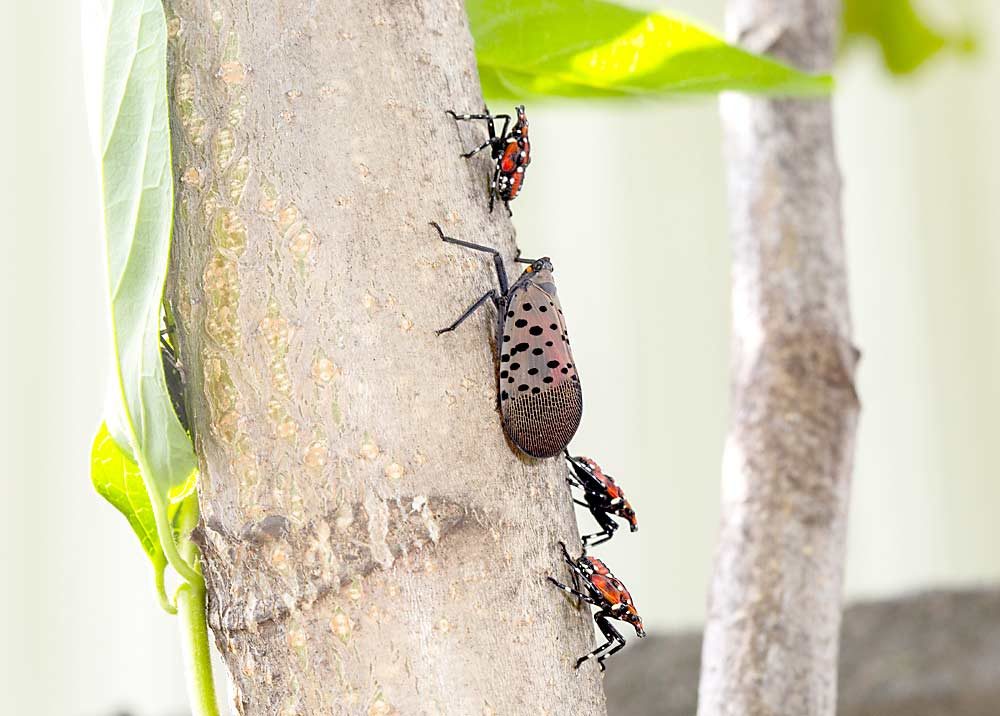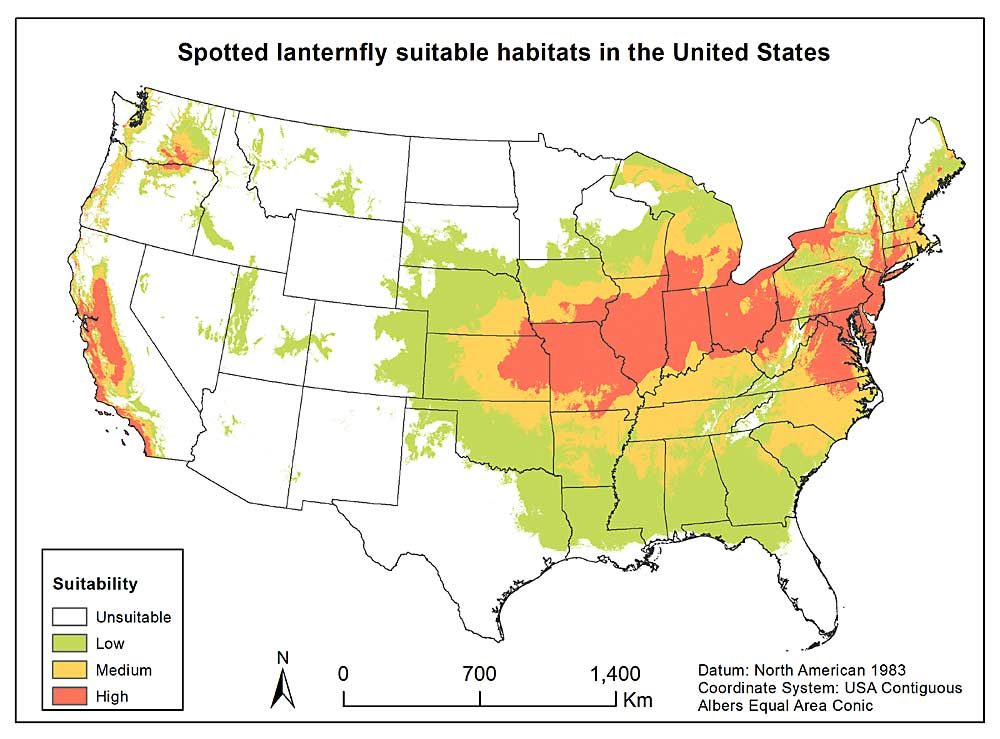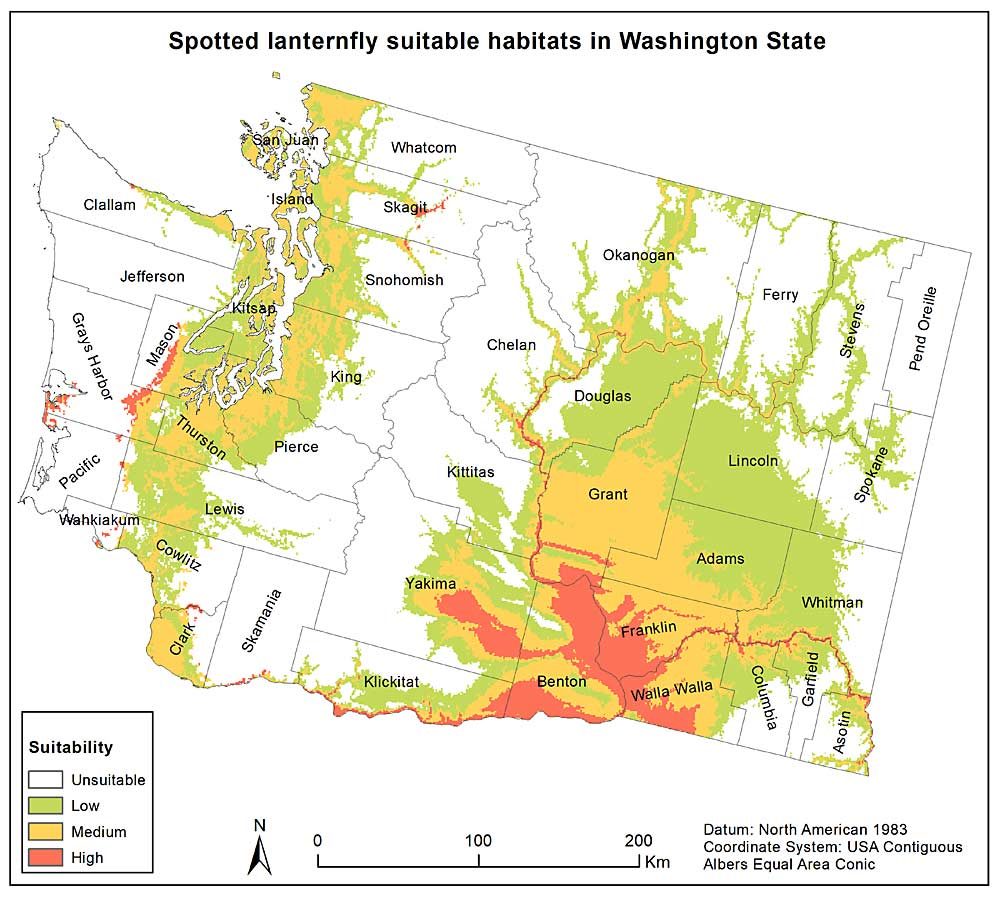
Our group at the U.S. Department of Agriculture Agricultural Research Service’s Temperate Tree Fruit and Vegetable Research Unit in Wapato, Washington, closely follows the spread of new invasive pests in the United States and globally. Over the past five years, we have developed invasive species establishment risk maps for many insect pests, including the oriental fruit moth, codling moth, European cherry fruit fly, western cherry fruit fly and apple maggot fly. In this article, we report the establishment risk of the spotted lanternfly, Lycorma delicatula, in Washington, determined using an ecological model.
The spotted lanternfly is a planthopper that feeds on more than 70 plant species, including grape, hop, apple, pear, cherry, maple and walnut. It damages these plants in two distinct ways: First, it weakens plants by directly sucking sap from all parts of the plant, including the trunk, branches, twigs and leaves. Second, it facilitates mold growth by spreading the sap and exuding honeydew on the plants, which provides a medium for subsequent mold growth. When hundreds of spotted lanternflies join forces and feed on a single tree, they can severely damage or even kill it.
Originally from China, the spotted lanternfly has spread into Japan, Korea and, more recently, into the United States. In the United States, it was first detected in Berks County, Pennsylvania, in 2014. Since then, it has spread into many neighboring counties and states, including New Jersey, Delaware and Virginia.
The potential economic damage to the grape, hop, tree fruit and timber industries caused by the lanternfly in the United States is substantial. Comprehensive economic damage assessments are not available, but reports from Pennsylvania indicate that at some sites, spraying costs have increased from $55 per acre to $148 per acre, a 169 percent increase.
The spotted lanternfly is highly attracted to the tree of heaven, an invasive plant from China that is distributed across every state in the U.S. except Montana, Wyoming, North Dakota and South Dakota. So far, host plant studies conducted in the United States have indicated that spotted lanternfly can develop from first instar into an adult on tree of heaven, hop, black walnut and chinaberry plants.
The detection of this pest in the Eastern United States, and the huge potential economic damage to the Pacific Northwest fruit industry, prompted us to investigate the question: “If introduced, can spotted lanternfly establish in Washington?”
We answered this question using the Maxent ecological modeling technique. Maxent is a machine learning technique that relies on species-presence data (i.e., sites where the pest is present now) and long-term environmental data such as mean monthly temperature and rainfall.
The logic is that if we know where the pest is present now and what environmental conditions it prefers, then we can evaluate all geographic locations and decide whether these locations are suitable or not suitable for establishment of the pest. Compared with 16 other similar techniques used on 266 species, the Maxent modeling approach was found to be one of the most accurate modeling approaches in risk analysis.
We obtained spotted lanternfly presence data from many sources, including published articles, online databases and cooperators in the Eastern United States and China. We also gathered environmental data from online sources. Finally, we applied the Maxent model and created spotted lanternfly establishment risk maps for the United States and Washington. Accuracy tests, done with independently collected data, indicated that our model was highly accurate.

Results show that if introduced, the spotted lanternfly could establish in the Pacific Northwest (Figure 1). Many counties in Washington have suitable habitats for spotted lanternfly, including Benton, Franklin, Yakima, Walla Walla and Klickitat counties (Figure 2). Suitable habitats are found in both Eastern and Western Washington.

The potential distribution of spotted lanternfly closely matched that of the distribution of the tree of heaven, the invasive plant from China. Areas with dry seasonal temperatures ranging from 19 to 45 degrees Fahrenheit and elevation ranging from 0 to 1,000 meters (about 3,280 feet) are highly suitable for spotted lanternfly establishment. Previous studies have determined that low winter temperature will increase spotted lanternfly egg mortality.
Proactive measures, including control of tree of heaven, are needed to prevent the introduction of this pest into Washington. For additional information, refer to our article entitled “The Establishment Risk of Lycorma delicatula (Hemiptera: Fulgoridae) in the United States and Globally,” published in the Journal of Economic Entomology on October 3, 2019. To read the article, go to: https://academic.oup.com/jee/advance-article/doi/10.1093/jee/toz259/5572115?searchresult=1)•
—by Lisa G. Neven, Tewodros T. Wakie and Wee L. Yee
Lisa G. Neven is the research
leader for USDA Agricultural Research Service’s Temperate Tree Fruit and
Vegetable Research Unit located in Wapato, Washington, where Wee L. Yee is a
research entomologist and Tewodros T. Wakie is a postdoctoral researcher.






[…] Results show that if introduced, the spotted lanternfly could establish in many counties in Washington. including Benton, Franklin, Yakima, Walla Walla, and Klickitat. Suitable habitats are found in both eastern and western Washington and because the spotted lanternfly’s preferred host is the tree of heaven (Ailanthus altissima), urban areas are at an increased risk as well. To read more about the analysis, visit the Entomology Today and Good Fruit Grower. […]